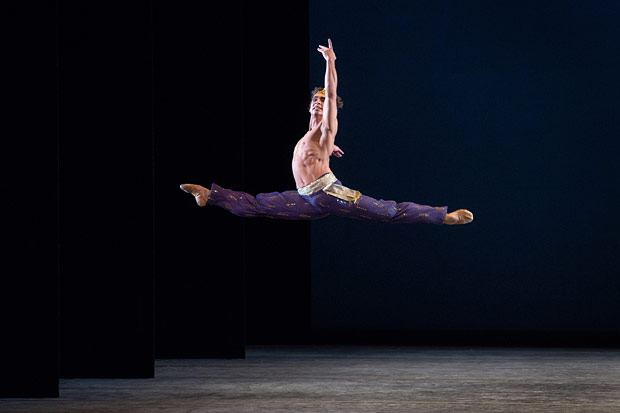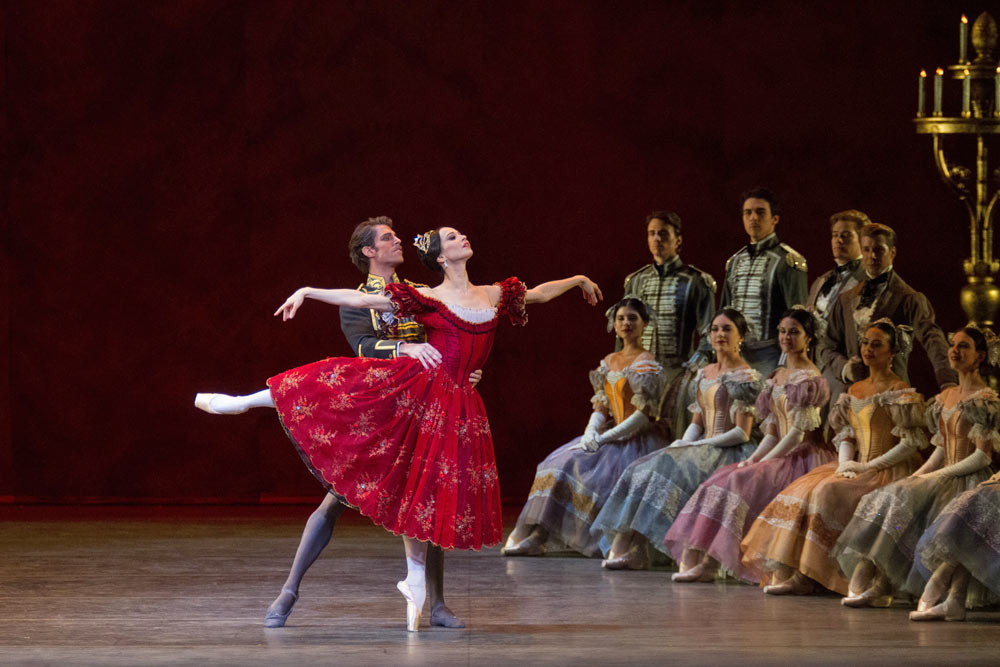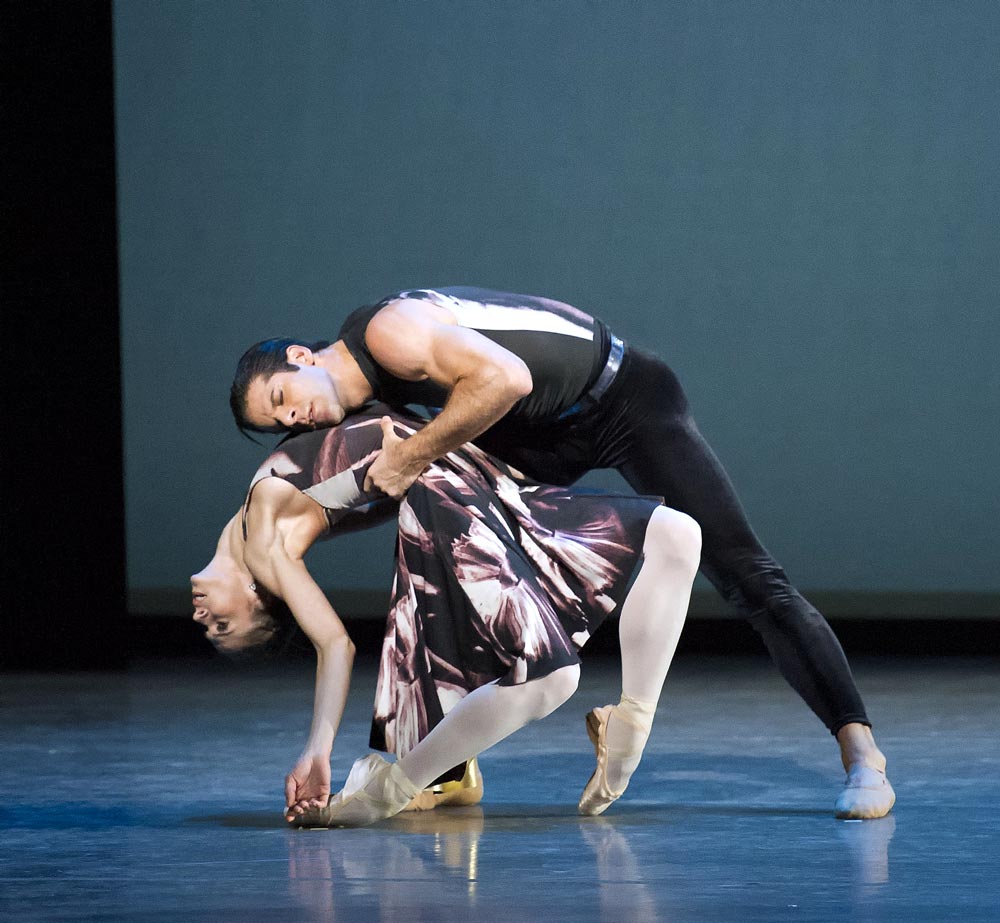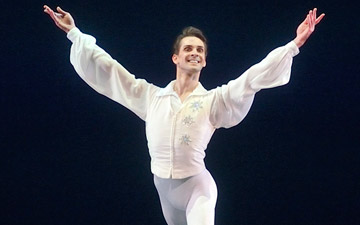
© Marty Sohl. (Click image for larger version)
American Ballet Theatre
Spring Gala: Onegin (Act III Excerpt), Cortège, Le Corsaire (Act II Pas de Deux and Coda), Symphony #9, Sylvia (Hunt Scene), Apothéose, The Sleeping Beauty (Act III Pas de Deux and Coda), Symphony in C
New York, Metropolitan Opera House
13 May 2013
www.abt.org
Gala Season, Part Two
The season of galas is upon us: New York City Ballet’s was held last week, American Ballet Theatre’s took place last night. As with most things, the two companies have contrasting approaches. NYCB tends to build its galas around a new ballet – this season, it was a pas de deux for Tiler Peck and Robert Fairchild by Christopher Wheeldon. ABT uses the occasion to roll out a series of out-takes from the season. NYCB presents a handful of top dancers; ABT tries to cram in as many as possible. At the Koch last week there were no speeches (a very good thing). At the Metropolitan Opera House, the company brass intoned the usual lines about being “America’s National ballet company” – what does that even mean? – and a dutiful Sigourney Weaver read a prepared speech full of facts and figures about the company-affiliated school.
A certain dutifulness crept into the programming as well. This trotting out of set pieces inevitably flattens things out. In such circumstances only the tricks, big jumps and multiple fouetté turns, really pop. Even full ballets – like Ratmansky’s Symphony #9 and Balanchine’s Symphony in C – start to look a little bit like extended excerpts. That said, thank god for these two ballets, which lifted the general spirit of the evening. Symphony in C, a luminous outpouring of legs and arms, crisp geometries, bobbing rhythms, and articulate patter-like conversations for the feet, is a vivid reminder of why one goes to the ballet at all. Luminosity and classical logic, laced with wit and intelligence. It closed the proceedings. The company looked ravishing in its cream-colored costumes (modeled after Karinska’s), and danced with easy musicality, more relaxed and with more épaulement than one sees at New York City Ballet, where Bizet is taken at a faster clip. Veronika Part made a striking appearance in the second movement, more tragic than one is used to, but regal and imposing, swimming through the long series of swoops and falls, building tension with each unbroken phrase as she shifted the air around her with her powerful arms and shoulders. As with a great dramatic soprano, one can forgive occasional flaws – imperfect balance, or a slightly open position of the feet – because of the power of her musicality. In the third movement Isabella Boylston and Daniil Simkin also stood out, well-matched in their soaring jumps and exuding a kind of irrepressible joy.

© Marty Sohl. (Click image for larger version)
Back to the excerpts. The evening opened with a polonaise and pas de deux from the final act of John Cranko’s costume drama, Onegin. The Mariinsky-trained Diana Vishneva danced with James Whiteside, a recent import from the Boston Ballet. He seems to have found his place in the company quite quickly, in part because he is a skillful partner, present but self-effacing and utterly self-assured. (A talent more rare than one might think.) This is a rather tepid duet, laced with small images of loving partnership – foreheads touching, walking steps with linked arms – that make sense in the larger context of the ballet, but less so as a stand-alone piece. In any case, Vishneva was convincingly dignified and tender, dancing as if lost in her own thoughts. She looked ravishing in her crown and red dress.

© Marty Sohl. (Click image for larger version)
This was followed by a charmingly formal demonstration of classroom technique (Cortège) by a group of students from the Jacqueline Kennedy Onassis School and members of the Studio Company set to the familiar “Procession of the Nobles” from Rimsky-Korsakov’s opera Mlada. Each dancer had a moment to shine. The students’ port de bras, soft and beautifully shaped, was a particular pleasure. It was funny to see the contrast between this formal demonstration and what followed: a display of just how un-classical today’s dancers can be. I wonder if the faculty shielded the young dancers’ eyes as Ivan Vasiliev tore across the stage like a panther and planted himself behind Xiomara Reyes, placing his hands on her waist with workmanlike focus. (Vasiliev and Reyes, a last-minute stand-in for an injured Natalia Osipova, performed the slave pas de deux from Le Corsaire. It’s not a gala without it.) Vasiliev is no paragon of elegance, that’s for sure, but his sheer exuberance, and the power of his jumps and lifts, makes him an undeniable presence onstage. No-one does an overhead lift like Vasiliev; he seems to want to propel his ballerina into the stratosphere. If he could dislocate his shoulder to get her even higher, he would. There’s something to be said for this kind of verve.

© Marty Sohl. (Click image for larger version)
After the break, three more excerpts: Gillian Murphy and her fellow nymphs bounded through the (invisible) forest in the Wagnerian opening of Sylvia, clutching their hunting bows like warrior princesses. The lithe Hee Seo, recently promoted to principal, took her first steps as Aurora in an abridged version of the wedding pas de deux from Sleeping Beauty. It was an auspicious début, filled with achingly beautiful shapes, high passés, deep lunges, lingering balances, everything just so. More than anything, one noticed the breadth in her arms and hands. She and her prince, David Hallberg, cut a very handsome figure indeed. The interpretation, and their partnership, can only grow from here. For Julie Kent and Roberto Bolle there was a pièce d’occasion by Marcelo Gomes in which the two appeared to wake from a nap and struggle toward a light – the piece was called Apothéose – accompanied by the march-like “allegretto” from Beethoven’s Seventh Symphony. At one point, the shirtless Bolle seemed to suddenly go blind, pawing at the air frenetically. In response, Kent ran to him and rolled over his back, to which he responded by holding her in an upside down lift. With the dying strains of the allegretto, Bolle collapsed to the ground. Kent caressed his head, as if he wre a beloved pet. They kissed. She fell toward him, and the two returned to their nap. Apothéose finie.

© Gene Schiavone. (Click image for larger version)
So much for the excerpts. Alexei Ratmansky’s Symphony #9, the opening section of an all-Shostakovich evening that will have its first performance on May 31st, got slightly lost in the shuffle. It needs brighter lighting. Even so, the musicality and complexity of the choreography are immediately compelling. Like the symphony to which it is set, it has a mocking, off-kilter tone. One doesn’t know whether to take it quite seriously. The first movement is playful, punctuated with skips and staccato hops and boys propelling each other into the air. The two soloists, Craig Salstein and Simone Messmer, could be young pioneers on parade. The second, accompanied by a sinuous clarinet, is more ominous. Marcelo Gomes and Polina Semionova are a couple in peril, peering into the darkness for their foes. Their movements are stretched, and then clipped, furtive and tilted, with tango inflections. The couple creep off as a group of men erupts on the scene, scooping through the air with heavy movements. Then Herman Cornejo appears, a kind of guiding spirit, and leads the group away, perhaps to safety. It’s all very mysterious. More struggles lie ahead. At one point the main couple seem to die, falling to the floor in stages; this is later echoed by the corps. The ending is a wild accelerando, peppered with folk steps and pithy quotations from the other movements. Cornejo is the whirling dervish at its heart; as the curtain descends, he’s still spinning. It’s almost too much to take in all at once, a breathless cornucopia of steps and images: parades, war, death, communal celebrations, folk dances, fear, the presence of magical beings in our midst. Not really gala fare, but an intriguing taste of what’s to come.

















[…] American Ballet Theatre held its spring gala at the Metropolitan Opera House on May 13, kicking off the season. It included the usual mix of excerpts, but also full performances of Balanchine’s Symphony in C and Ratmansky’s Symphony No. 9. You can read my review for DanceTabs here. […]
Dear Marina,
I did not go to the gala last night. However, your review made me feel as if I was there. I must tell you that I appreciated it so much more than I did the review of Mr. Macaulay.
Thank you.
Best,
Barbara Thau
I went to NYCB Gala and also to ABT. I think NYCB was a better performance but ABT had more models and actors in attendance, which seems very important to ABT.
I had the identical reaction to you regarding “America’s National Ballet Company” — what the heck does that even mean.
I had to look this up “épaulement ” and I still don’t know what it means but ABT isn’t going to best NYCB at Symphony in C.
“Vasiliev is no paragon of elegance”
Yes, but they like to trot him out at the gala. He should be performing with Barnum & Bailey but the audience eats it up. And the ABT audience is most definitely not that Gala audience. It’s more of a foreign crowd (with a lot of Russians) because, you know, it’s “American’s Dance Company.”
Which reminds me. This audience does not and I suspect will not ever get excited about Hee Seo. They want Osipova. Seminova. What they seem to want from “America’s Dance Company” are Russian Ballerinas. And the more show the better (Vasiliev, Osipiva)
Oh no, does anyone know what Osipova’s injury is? (Selfishly, I’ll be very disappointed not to see her next month, if she’s still injured… And, it would be horrific if it’s anything major.)
Re Osipova: I heard it’s only slight, something to do with her foot, and not expected to keep her from the stage for long.